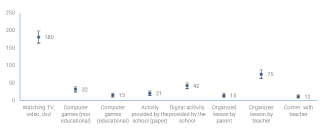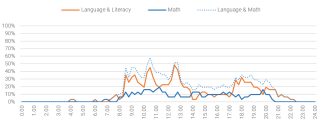
COVID-19
My time, your time, our kids’ time.
December 10, 2020
Like every parent, I found myself in March both working from home and scaffolding and supporting my kids every day of their remote schooling. After the summer break, the juggling resumed and continues still today.
My school district’s remote learning program is more structured now than last spring, yet I can’t stop thinking about how our children are using their time while not physically in school.
Time is a precious resource for child development and for many other parent activities. Working extended hours, irregular job schedules, and multiple jobs greatly limits the time we have to support our children, scaffold their learning, and engage with them in playful interactions and meaningful conversations.
When children are in a preschool or school program, their time is (hopefully) sensibly managed by teachers. But when they’re home, children demand our time, and too often that demand conflicts with our professional responsibilities.
Faced with this conflict, I wanted to know more about how other children use their time in the pandemic context.
Collaborating with my NIEER colleagues in the spring of 2020, I set out to determine if time diaries could capture subtle differences in children’s experiences. We surveyed 31 parents of preschool, kindergarten, and first-grade children, asking them to describe what their children did within a 24-hour period, breaking down their activities into fifteen-minute intervals. Before the school year ended, we surveyed a third of these parents a second time.
The time diary survey captured nuanced patterns in children’s daily time use:
- Children spent only one to two hours on school-related activities that include paper, digital activities, or lessons provided by their teacher.
- Kindergarten and first-grade children spent slightly more time on school-related activities than younger children.
- Screen time and educational experiences varied significantly. Television watching varied from zero to more than 10 hours.
- Children engaged in language and literacy activities did so for meaningful amounts of time, but not all children engaged in these activities daily. Children spent on average 39 minutes per day reading, yet 42% did not read a book with an adult and many did not read on their own either.
- While combined indoor and outdoor physical activity (exercise) averaged about two hours per day, about 40% of children were not engaged in physical activity on a given day.

Time diaries allowed us to assess patterns of engagement throughout the day (Figure 2). In our small sample, language and literacy and math participation rates tended to be higher in the morning, peaking between 10 and 11 AM for about 60 percent of the sampled children. Rates picked up again briefly around lunchtime and again between 5 and 9 PM around bedtime.

Acknowledging this was not a representative sample, I did find that time diaries allowed us to see what parents and children were experiencing. With time diaries, we can observe the timing and nature of children´s learning engagement and the degree to which children meaningfully engaged in learning activities. Additionally, time diaries capture this data across a wide mix of activities.
We can tell who is or isn’t engaged with learning activities of different types and content, to what degree children are engaged alone or supported by an adult, and how long children remain engaged.
Our findings made me wonder if time diaries could advance what we know about children’s learning activities in general and the pandemic’s impact on those activities specifically.
Using larger samples and repeating the survey over several days, we could explore children’s learning activities within many household subgroups, such as urban, suburban, and rural households, dual working households and single-parent households. We can also see how activities might vary with family background characteristics including race/ethnicity, income, and parental education.
Time diary surveys can help us understand how the availability and allocation of the scarce resources of children’s and parents’ time shape children’s learning experiences. By helping our field more fully understand how to support children and their parents through the day, time diary surveys can lead to improved learning opportunities and physical activities for our youngest learners.
The Authors
Dr. Milagros Nores is the Co-Director for Research and Research Professor at the National Institute for Early Education Research (NIEER). With a profound expertise in early childhood evaluation, informing data-driven policy and programming, cost and benefits of early interventions, evaluation design, equity, and English language learners, she has established herself as a leading researcher in the field of early care and education.
About NIEER
The National Institute for Early Education Research (NIEER) at the Graduate School of Education, Rutgers University, New Brunswick, NJ, conducts and disseminates independent research and analysis to inform early childhood education policy.

